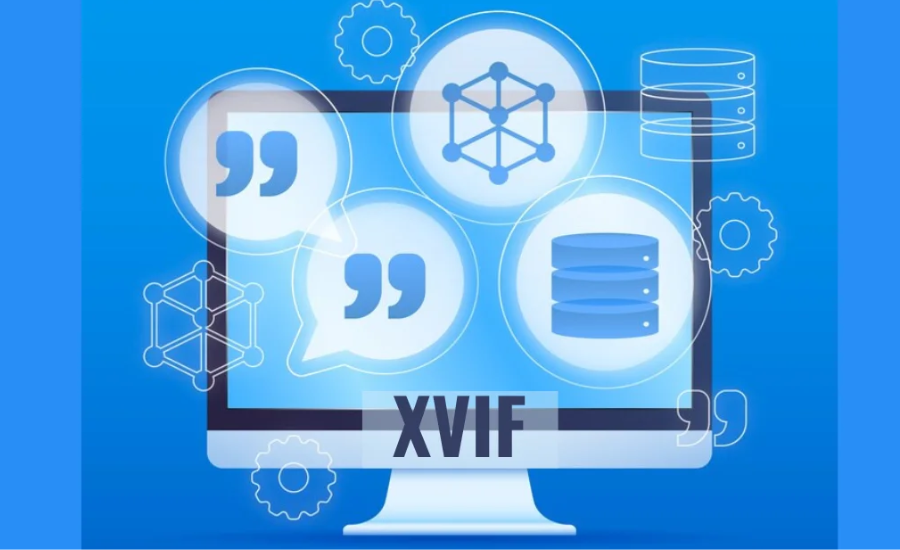In the digital media landscape, video content dominates. From streaming platforms to social media, video is a powerful medium that engages audiences and delivers information dynamically. However, with the ever-increasing demand for high-definition (HD) and ultra-high-definition (UHD) content, efficient video compression technology has become crucial. Enter XVIF, a cutting-edge video compression format poised to revolutionize how we store and stream video content. This article delves into the intricacies of XVIF, exploring its technology, advantages, applications, and potential impact on the future of digital media.
Understanding XVIF: The Basics

The eXtensible Video Interchange Format (XVIF) represents a next-generation video compression standard engineered to overcome the limitations of current formats such as H.264 (AVC) and H.265 (HEVC). Developed collaboratively by a consortium of leading technology companies and research institutions, XVIF is designed to deliver exceptional compression efficiency, significantly improving video quality while maintaining smaller file sizes. Additionally, XVIF boasts enhanced adaptability, making it ideal for a wide range of devices and network conditions. This advanced format promises to set a new benchmark in video compression, addressing the evolving needs of digital media consumption.
Key Features of XVIF

- High Compression Efficiency : XVIF excels in achieving remarkable compression rates, drastically reducing file sizes while maintaining high video quality. This efficiency is particularly advantageous for streaming services and storage solutions, as it significantly lowers bandwidth consumption and storage demands. By optimizing the balance between compression and quality, XVIF ensures that users can enjoy high-definition content without the burden of large file sizes or excessive data usage.
- Scalability and Adaptability : Designed with versatility in mind, XVIF supports scalable video coding (SVC), allowing a single video to be encoded once and then dynamically adjusted in resolution and bitrate according to the viewer’s device and network speed.
- Advanced Error Resilience : XVIF incorporates cutting-edge error correction techniques to maintain smooth playback even in challenging network environments.
- Enhanced Video Quality : Through the use of state-of-the-art algorithms, XVIF delivers exceptional video quality even at lower bitrates.
- In summary, XVIF offers a comprehensive solution to the challenges of modern video compression, combining high compression efficiency, scalability, advanced error resilience, and enhanced video quality. This makes it an ideal choice for the evolving demands of digital media consumption.
The Technology Behind XVIF

XVIF’s cutting-edge capabilities are driven by its innovative technology stack, composed of several crucial components:
Superior Compression Algorithms
At the heart of XVIF’s efficiency are its advanced compression algorithms. These algorithms significantly reduce file sizes without compromising video quality, making it possible to stream and store high-definition content with minimal bandwidth and storage requirements.
Scalable Video Coding (SVC)
XVIF’s scalability is achieved through Scalable Video Coding (SVC). This technology allows a single video to be encoded once and then dynamically adjusted in resolution and bitrate. As a result, the video can seamlessly adapt to various devices and network conditions, ensuring a consistent and high-quality viewing experience for all users.
Robust Error Resilience Techniques
XVIF integrates robust error correction techniques to enhance its resilience in fluctuating network environments. This ensures smooth playback and uninterrupted viewing, even during live streaming and video conferencing where network stability can be an issue.
Enhanced Encoding Methods
XVIF leverages sophisticated encoding methods that enhance video quality even at lower bitrates. These methods preserve fine details and reduce visual imperfections, delivering crisp, clear video that rivals higher bitrate formats.
Adaptive Bitrate Streaming
XVIF supports adaptive bitrate streaming, allowing the video quality to automatically adjust based on the viewer’s internet speed. This ensures optimal performance and visual clarity, regardless of fluctuations in network bandwidth.
Multi-Device Compatibility
XVIF is designed for compatibility with a wide range of devices, from smartphones and tablets to desktop computers and smart TVs. This ensures that users can enjoy a high-quality viewing experience on any platform.
By combining these advanced technologies, XVIF sets a new standard for video compression, offering unmatched efficiency, quality, and adaptability. This makes it an ideal solution for the demands of modern digital media consumption, from streaming services to video conferencing and beyond.
Advantages of XVIF Over Existing Formats

Superior Compression Efficiency
One of XVIF’s most notable advantages over older formats such as H.264 and H.265 is its exceptional compression efficiency. XVIF is capable of reducing file sizes by up to 50% compared to H.264 and around 30% compared to H.265. Remarkably, it achieves these reductions while maintaining or even enhancing video quality. This heightened efficiency translates to significant cost savings in storage and bandwidth, making XVIF an ideal solution for streaming platforms and content creators alike. With XVIF, users can enjoy high-definition content with faster loading times and less data consumption, ultimately enhancing the overall viewing experience.
Improved Video Quality
Thanks to its advanced encoding techniques and machine learning enhancements, XVIF delivers superior video quality at lower bitrates. This technology ensures that viewers experience crisp, clear images with minimal compression artifacts, even on large screens and high-resolution displays. The improvement is especially pronounced in UHD and 4K content, where maintaining fine detail is crucial. By leveraging sophisticated algorithms, XVIF preserves the integrity of the visual content, offering an immersive viewing experience that surpasses what older formats can achieve. This makes XVIF particularly well-suited for applications where high visual fidelity is essential, such as premium streaming services, digital cinema, and professional video production.
Enhanced Adaptability
XVIF’s scalability and adaptability make it exceptionally well-suited for the diverse range of devices and network conditions prevalent today. Whether viewers are using a high-speed fiber connection or a slower mobile network, XVIF dynamically adjusts the video stream in real time to ensure optimal playback. This flexibility extends to various screen sizes and resolutions, from smartphones to 8K TVs. By supporting scalable video coding (SVC), XVIF allows a single video file to be encoded once and then adapted to different bitrates and resolutions on the fly. This means that whether you are watching on a small mobile device or a large 8K television, XVIF can provide a seamless and high-quality viewing experience, making it an ideal solution for modern, multifaceted digital consumption environments.
Better Error Resilience
XVIF’s advanced error correction capabilities ensure a smoother viewing experience, even in suboptimal network conditions. This resilience is crucial for applications like live streaming and video conferencing, where network interruptions can cause significant disruptions. XVIF utilizes sophisticated error correction algorithms to minimize buffering and prevent dropped frames, resulting in a more seamless and reliable viewing experience. This robustness ensures that viewers can enjoy uninterrupted content, making XVIF an ideal choice for both real-time streaming and on-demand video services, where maintaining high quality is essential despite fluctuating network performance.
Applications of XVIF
Streaming Services
With its exceptional compression efficiency and superior video quality, XVIF is an ideal solution for streaming services. By significantly reducing file sizes without compromising on quality, streaming platforms can deliver high-definition and ultra-high-definition content to millions of users worldwide. This efficiency not only reduces bandwidth usage but also lowers storage costs, making content delivery more economical. Additionally, XVIF’s scalability ensures that viewers, whether on high-speed fiber connections or slower mobile networks, receive a consistent and high-quality streaming experience. This adaptability extends to various devices and screen sizes, from smartphones to 8K TVs, guaranteeing optimal playback across all viewing conditions.
Video Conferencing
In the era of remote work and virtual meetings, video conferencing has become an essential communication tool. XVIF’s low-latency encoding and advanced error resilience make it perfect for applications like Zoom, Microsoft Teams, and Google Meet. This cutting-edge technology ensures that participants experience high-quality video calls with minimal delay and fewer interruptions, even in challenging network environments. By providing smooth, reliable video streams, XVIF enhances the overall effectiveness of virtual meetings, allowing for clearer communication and more productive collaboration regardless of participants’ network conditions.
Content Creation AEditing
For content creators and video editors, XVIF presents numerous advantages. Its exceptional compression efficiency significantly reduces file sizes, which simplifies the storage and transfer of large video files. This efficiency not only saves storage space but also speeds up the workflow by minimizing the time required for file transfers and uploads.
Moreover, XVIF’s commitment to maintaining superior video quality is particularly beneficial for content creators. Even after multiple rounds of editing and compression, XVIF preserves the details and clarity of the video, ensuring that the final product retains a professional and polished appearance. This high-quality output is crucial for maintaining the integrity of the content throughout the editing process and for delivering a visually appealing experience to viewers.
By leveraging XVIF, content creators and video editors can streamline their workflow, reduce storage costs, and consistently produce high-quality videos that meet professional standards. This combination of efficiency and quality empowers creators to focus more on creativity and content development, knowing that their technical needs are well-supported by XVIF’s advanced capabilities.
Broadcasting
Television networks and broadcasters stand to gain substantial advantages from XVIF’s cutting-edge capabilities for both live and recorded content. XVIF excels in delivering smooth, high-quality broadcasts through its low-latency encoding and robust error resilience. These features are crucial for ensuring that viewers experience minimal delays and interruptions, even in challenging network conditions.
One of XVIF’s standout benefits is its superior compression efficiency, which significantly reduces the bandwidth needed for transmitting video content. This efficiency is particularly valuable during live sports and events, where maintaining high video quality is paramount. By minimizing bandwidth requirements, XVIF enables broadcasters to stream high-definition and even ultra-high-definition content to audiences worldwide without compromising on visual clarity or reliability.
Furthermore, XVIF’s adaptability to diverse network environments ensures that broadcasters can consistently deliver a seamless viewing experience across various platforms and devices. Whether viewers are streaming content on smart TVs, mobile devices, or computers, XVIF adjusts dynamically to optimize playback quality based on available network speeds and device capabilities.
In essence, XVIF empowers television networks and broadcasters to enhance their broadcasting capabilities with advanced technology that supports high-quality, low-latency streaming. By leveraging XVIF, broadcasters can elevate the viewer experience during live broadcasts and recorded content, setting new standards for video transmission in the broadcasting industry.
Virtual Reality And Augmented Reality
As virtual reality (VR) and augmented reality (AR) technologies advance, there is a rising need for high-quality, low-latency video content to support immersive experiences. XVIF stands out as an ideal solution for these applications due to its advanced encoding techniques and low-latency capabilities. This combination ensures that users can enjoy smooth, high-resolution VR and AR content with minimal delay, thereby enhancing the overall immersive experience.
The key strength of XVIF lies in its ability to efficiently compress video data while maintaining exceptional quality. This is particularly crucial in VR and AR environments where users expect realistic visuals and fluid motion to feel fully immersed in virtual worlds or interactive augmented reality overlays. XVIF’s advanced encoding technologies enable it to deliver sharp details, vibrant colors, and consistent frame rates, all essential for creating compelling VR and AR experiences.
Moreover, XVIF’s low-latency encoding ensures that there is minimal delay between user actions and the corresponding visual feedback. This responsiveness is critical for interactive VR applications, such as gaming, virtual tours, or training simulations, where any latency can disrupt the sense of presence and immersion. By reducing latency, XVIF enables seamless interaction within virtual environments, enhancing the overall engagement and usability of VR and AR applications.
In summary, XVIF is well-suited to meet the demands of VR and AR technologies by providing high-quality, low-latency video content. Its advanced encoding capabilities optimize the viewing experience, allowing users to enjoy immersive VR and AR content with smooth performance and minimal delay, thereby pushing the boundaries of what’s possible in virtual and augmented reality experiences.
The Future Of XVIF

While XVIF is currently in the early stages of adoption, its potential to revolutionize video compression is increasingly recognized across various sectors. Streaming services, content creators, and broadcasters are beginning to appreciate the significant advantages that XVIF offers. These include superior compression efficiency, which reduces bandwidth requirements and storage costs while maintaining high video quality. As awareness of these benefits spreads, XVIF’s adoption is expected to expand rapidly.
Looking ahead, ongoing advancements in machine learning and encoding technologies are poised to further enhance XVIF’s capabilities. These innovations will contribute to even greater compression efficiency, allowing XVIF to handle higher resolutions and frame rates with improved fidelity. Moreover, advancements in error resilience and low-latency encoding will ensure that XVIF remains competitive in applications requiring real-time transmission, such as live sports broadcasts and interactive VR experiences.
As XVIF continues to evolve, it is anticipated to solidify its position as a leading video compression format. Its ability to adapt to evolving technological demands and its superior performance in delivering high-quality, low-latency video content will drive its widespread adoption. Ultimately, XVIF is poised to shape the future of video compression by enabling more efficient, immersive, and accessible multimedia experiences across digital platforms and industries.
Potential Challenges
Despite its significant advantages, XVIF faces several challenges that could influence its adoption in the video compression landscape:
- Compatibility: One of the primary challenges for XVIF is ensuring compatibility across a diverse array of devices and platforms. This requires close collaboration between hardware manufacturers, software developers, and content providers. Ensuring that XVIF-encoded content can be seamlessly played back on different devices, ranging from smartphones to smart TVs, is crucial for its widespread adoption.
- Licensing and Patent Issues: Like many new technologies, XVIF may encounter challenges related to licensing and patent issues. Addressing these concerns effectively will be essential to prevent legal disputes and ensure that XVIF can be used without restrictive licensing barriers. Clearing these hurdles will promote broader adoption by encouraging content creators and service providers to embrace XVIF without concerns over intellectual property rights.
- Standardization: Establishing XVIF as an industry standard is another critical hurdle. Standardization involves defining technical specifications and protocols that ensure interoperability and reliability across various applications and environments. This process typically involves industry bodies, standards organizations, and stakeholders working together to ratify XVIF as a recognized and widely accepted compression format. Achieving standardization will facilitate broader implementation and integration of XVIF into existing workflows and technologies.
FAQs About XVIF
Q: What is the full form of XVIF?
A: XVIF stands for eXtensible Video Interchange Format, representing a next-generation video compression standard aimed at enhancing compression efficiency, video quality, and adaptability across various digital platforms.
Q: How does XVIF differ from existing video formats like H.264 and H.265?
A: XVIF surpasses older formats such as H.264 and H.265 by offering significantly higher compression efficiency. It reduces file sizes by up to 50% compared to H.264 and approximately 30% compared to H.265, all while maintaining or even enhancing video quality. Additionally, XVIF incorporates advanced error resilience, scalability, and adaptability to diverse devices and network conditions.
Q: What are the key features of XVIF?
A: Key features of XVIF include:
- High Compression Efficiency: XVIF achieves remarkable compression rates, minimizing bandwidth usage and storage requirements, ideal for streaming services and content creators.
- Scalability and Adaptability: It supports scalable video coding (SVC), enabling dynamic adjustments in resolution and bitrate based on viewer devices and network speeds.
- Advanced Error Resilience: XVIF integrates advanced error correction techniques, ensuring smooth playback even in challenging network environments.
- Enhanced Video Quality: Utilizing state-of-the-art algorithms, XVIF preserves detail and reduces imperfections, delivering superior video quality at lower bitrates.
Q: What technology does XVIF use to achieve its capabilities?
A: XVIF employs a blend of traditional block-based encoding, wavelet-based compression, adaptive quantization, machine learning enhancements, and low-latency encoding techniques. These technologies collectively contribute to its exceptional performance in video compression and delivery.
Q: How does XVIF handle different network conditions?
A: XVIF’s support for scalable video coding (SVC) allows content to be encoded once and adjusted dynamically in resolution and bitrate. This adaptive capability ensures optimal playback quality across varying network conditions, accommodating both high-speed connections and slower mobile networks effectively.
Conclusion
XVIF, short for eXtensible Video Interchange Format, represents a cutting-edge leap forward in video compression technology. Built to surpass the limitations of established formats like H.264 and H.265, XVIF introduces groundbreaking advancements in compression efficiency, video quality, scalability, and adaptability. These core attributes position it as the preferred solution across diverse applications such as streaming services, video conferencing, content creation, broadcasting, and immersive VR/AR experiences.
At the heart of XVIF lies an innovative technology stack integrating hybrid encoding algorithms, adaptive quantization techniques, machine learning enhancements, and low-latency encoding capabilities. This robust foundation ensures XVIF remains at the forefront of video compression, capable of delivering superior performance and maintaining high standards of visual fidelity across various devices and network conditions.
As the digital media landscape continues its rapid evolution, the widespread adoption of XVIF promises to revolutionize how video content is stored and streamed. By offering both efficiency and enhanced quality, XVIF enhances the overall viewing experience for consumers while providing content creators with powerful tools to deliver compelling, high-definition content seamlessly.
Despite potential challenges related to compatibility across different platforms, navigating licensing agreements, and establishing industry-wide standards, XVIF’s advanced features and tangible benefits position it as a transformative force in the future of digital media. As stakeholders increasingly recognize its potential to streamline video content delivery, XVIF is poised to emerge as a pivotal player in shaping the next generation of video compression standards, ushering in a new era of efficiency, quality, and adaptability in video technology.
Stay in touch for more updates and alerts visit: Cofee Manga!
